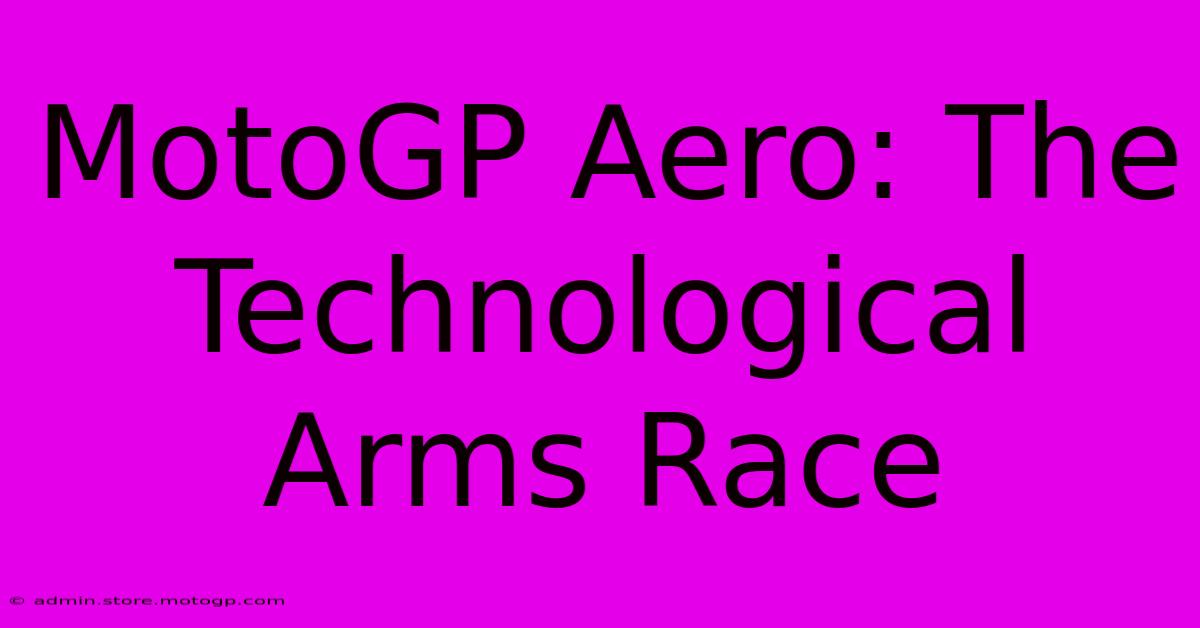MotoGP Aero: The Technological Arms Race

Table of Contents
MotoGP Aero: The Technological Arms Race
MotoGP, the pinnacle of motorcycle road racing, is a relentless pursuit of speed and performance. But the quest for those crucial tenths of a second isn't just about horsepower; it's increasingly about aerodynamics. The technological arms race in MotoGP aero is a fascinating blend of cutting-edge engineering, innovative design, and intense competition, pushing the boundaries of what's possible on two wheels.
The Importance of Aerodynamics in MotoGP
In the fiercely competitive world of MotoGP, even small aerodynamic improvements can translate into significant gains on the track. Aerodynamic efficiency directly impacts:
- Top speed: Reduced drag allows riders to achieve higher top speeds on straights.
- Cornering speed: Aerodynamic downforce helps keep the tires planted to the track, allowing for faster cornering speeds.
- Stability: Improved stability at high speeds contributes to safer and faster lap times.
- Rider comfort and control: Optimized airflow reduces rider fatigue and improves overall control.
The Evolution of MotoGP Aerodynamics
Early MotoGP bikes relied on basic fairings for wind protection. However, as speeds increased, the need for more sophisticated aerodynamic solutions became apparent. This led to the development of:
- Wings: These prominent appendages generate downforce, improving stability and cornering speed. The design and placement of these wings are constantly evolving, with teams experimenting with different configurations to optimize performance.
- Streamlined fairings: Manufacturers invest heavily in Computational Fluid Dynamics (CFD) simulations to design fairings that minimize drag and maximize airflow efficiency. Every curve and surface is meticulously engineered to improve performance.
- Winglets: Smaller aerodynamic elements, strategically placed to manage airflow and reduce turbulence. These are often found on the front fairing and under the bike.
- Aerodynamic Devices: Teams continuously explore and experiment with novel aerodynamic devices, such as diffusers and underbody fairings, to enhance downforce and stability.
The Technological Arms Race: A Constant Battle for Advantage
The development of MotoGP aerodynamics is a constant back-and-forth, a technological arms race between manufacturers. Each team employs highly skilled engineers and invests heavily in research and development to gain a competitive edge. This involves:
- Wind tunnel testing: Teams use sophisticated wind tunnels to test various aerodynamic configurations and optimize designs.
- Computational Fluid Dynamics (CFD): CFD simulations allow engineers to virtually test different designs, saving time and resources.
- Track testing: Real-world testing on the track is crucial to validate simulations and fine-tune aerodynamic settings.
- Material Science: The use of advanced materials, such as carbon fiber, is critical to creating lightweight yet strong aerodynamic components.
The Regulatory Landscape
The governing body, Dorna Sports, plays a crucial role in regulating aerodynamic development. Rules are frequently updated to ensure fair competition and prevent excessive aerodynamic gains that might compromise safety. This ongoing regulatory process adds another layer to the technological challenge.
The Future of MotoGP Aero
The future of MotoGP aerodynamics promises even more innovative designs and technologies. We can anticipate further refinements in:
- Active Aerodynamics: Systems that adjust aerodynamic elements in real-time based on riding conditions.
- AI-driven Optimization: Artificial intelligence could play a significant role in optimizing aerodynamic designs and setup.
- Sustainable Materials: The industry will likely move towards more sustainable and environmentally friendly materials.
The technological arms race in MotoGP aero is a thrilling testament to human ingenuity and the relentless pursuit of speed. As teams push the boundaries of aerodynamic design, we can expect even more exciting and closely contested races in the years to come. The constant evolution ensures that MotoGP remains at the forefront of motorcycle technology, captivating fans worldwide with its speed, precision, and technological marvel.

Thank you for visiting our website wich cover about MotoGP Aero: The Technological Arms Race. We hope the information provided has been useful to you. Feel free to contact us if you have any questions or need further assistance. See you next time and dont miss to bookmark.
Featured Posts
-
Get Closer To The Action F1 Concert Tickets
Feb 18, 2025
-
Cota Parking Conquer Austin Like A Local
Feb 18, 2025
-
Moto Gp Sprint Race Results Witness The Speed And Strategy
Feb 18, 2025
-
Moto Gp Racing Time Things To Do
Feb 18, 2025
-
The Essential Guide To Moto Gp Points
Feb 18, 2025
